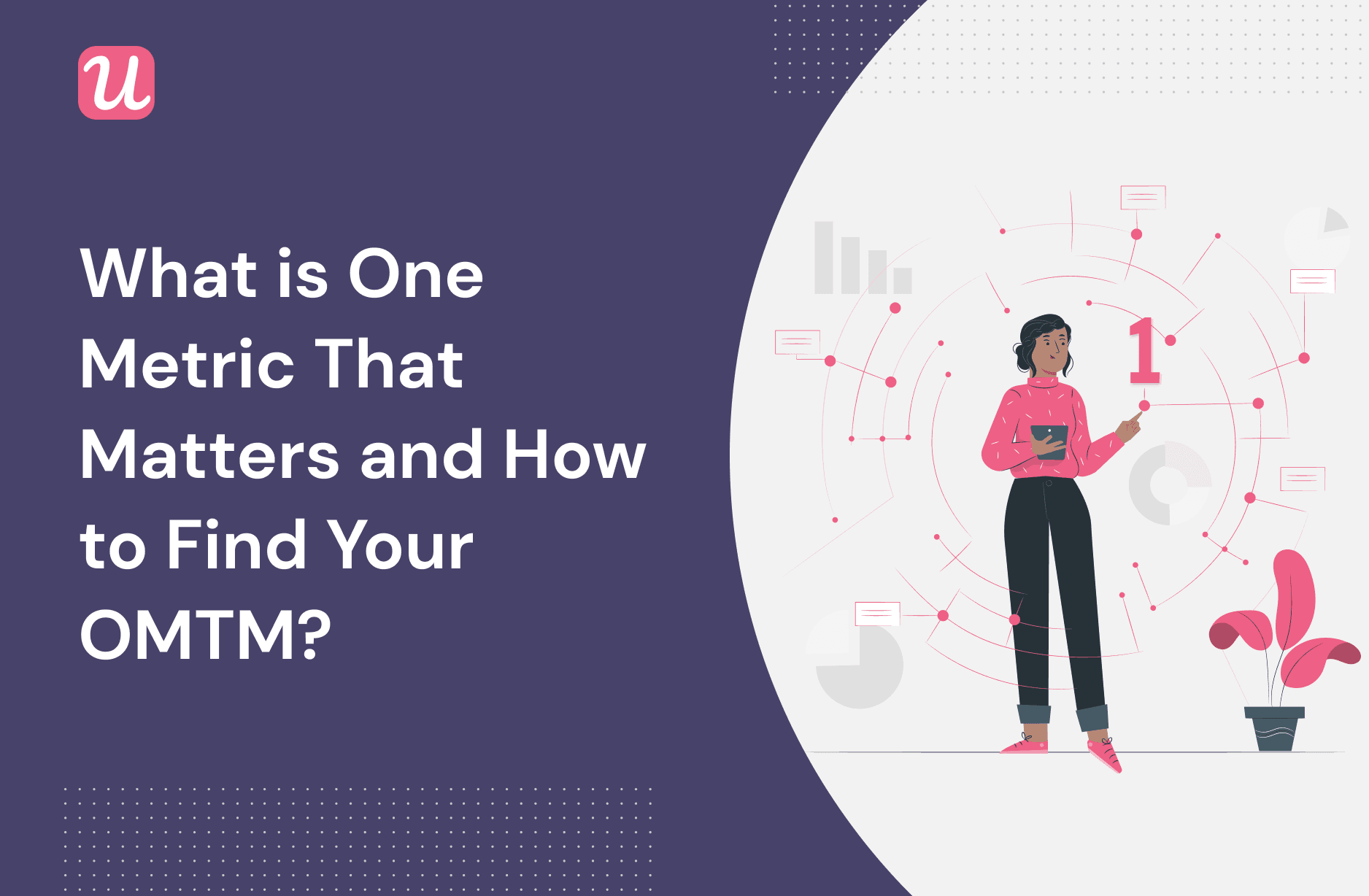
Get The Insights!
The fastest way to learn about Product Growth, Management & Trends.
What is “One Metric That Matters” (OMTM)?
In his book “Lean Analytics”, Ben Yoskovitz said that “One Metric That Matters” (OMTM) is the only metric you care about above anything else at any given time.
Having this metric doesn’t mean you don’t have to measure any other metrics. There are multiple SaaS metrics you need at different stages of the customer journey for marketing and growth purposes.
However, to cut through the noise created by all the data, you should have one metric that your company can focus on at any particular point in time.
Note that your OMTM can always change. We’ll discuss it later on in the article.
Why is using an OMTM important?
An OMTM is important for a number of reasons.
1. An OMTM provides a focus for your growth team members and the entire growth team as well. At any particular time, each of the members is aligned under one metric and knows exactly what to do for the business.
2. OMTM allows you to create a positive, long-term effect. If you can carefully select the right OMTM, you’ll become more likely to focus on the most impactful aspects of your business.
3. OMTM lets you get results more quickly. You can identify the primary issue you want to focus on and define a straightforward goal. For example, in the early stage of your business, you may want to make the conversion to trial users your OMTM.
You can then start experimenting with different solutions and learn along the way. You can even analyze the results with greater transparency.
4. According to the Lean Startup movement, experimentation is critical to startups. The book Lean Startup by Eric Ries stated that it’s crucial for businesses to go through the “Build> Measure> Learn” cycle as fast as possible.
This helps team members learn how to execute projects effectively. Moreover, it also builds a culture of experimentation all across the company, which is particularly important in the growth phase.
One Metric That Matters vs North Star Metric
A North Star Metric is a single quantitative indicator for the sustainable growth of a product. There’s usually only one North Star Metric for the entire business.
It should be directly associated with company profit, lifetime average revenue, or customer realization of value.
The North Star Metric you choose must be able to create a connection between your internal stakeholders and your product. Your product management team can then evaluate what you need to optimize in the business.
Consequently, your business can move on in the right direction and experience sustainable growth.
It can be difficult to choose just one metric to reflect the company’s growth. This is particularly true if your business model offers a vast range of products for different customer segments with different sets of needs.
In such a complex situation, any department’s members can be difficult to analyze their efforts with only a single metric.
Thus, One Metric That Matters (OMTM) allows you to select one specific metric for every department. Now, all departments can focus on one metric that correlates directly with their work.
So, the OMTMs are different key performance indicators for different departments. This allows every member of a department to know the metrics they should track and optimize individually.
Moreover, the OMTM has a direct effect on the North Star Metric. As you can see in the image below, there’s a different OMTM for each time at different periods. This allows team members to focus on the metric that is directly tied to their work for the given period.

While the different OMTMs ultimately complement the North Star Metric, there are some notable differences between the two concepts:
1. The One Metric That Matters is a ratio instead of an absolute or cumulative value. It is much more specific than the North Star Metric. It covers a maximum of one particular stage in the Pirate Funnel, which we will cover later in the article.
On the other hand, the North Star Metric brings the entire business under one umbrella instead of focusing on a particular department. Each business unit ultimately caters to the North Star Metric when they optimize their OMTM. Thus, these units should target the OMTM that contributes the most to your company’s North Star Metric.
2. Companies usually use the One Metric that Matters for 2-4 months. They later select another OMTM for the next period. However, the North Star Metric never changes until you change your entire business model. For instance, game developers walk a very fine line between customer acquisition and customer retention.
When it comes to acquisition, they emphasize the quality of their apps and thus use app KPIs. Plus, they focus on retention KPIs when it comes to in-game purchases.
Mobile features, for example, empower you to create intuitive mobile app KPI metrics and dashboards that provide clear insights into user behavior, engagement, and retention, crucial for tracking such specific OMTMs or supporting your North Star Metric.
3. You can only use an OMTM within the boundaries of your growth team. On the contrary, as mentioned earlier, the North Star Metric is for the entire company to focus on. As a result, if you have multiple growth hacking teams, you can have several OMTMs but only one North Star Metric.
OMTM examples
It’s natural for different startups to have different OMTMs based on their business models.
The image below shows some more examples of ‘One Metric That Matters’ for 4 well-known companies.
AirBnB’s North Star Metric is “Number of nights booked“because it perfectly combines the value of the booker and the lessor, so a good North Star Metric for a platform.

Square is a SaaS-enabled marketplace that earns its revenue via transaction fees charged on payments. Thus, its growth team uses the ‘Gross processing volume (GPV) as its OMTM to track the dollar amount of revenue generated from its transactions. The higher the GVP, the greater the transaction-based revenue.
Airbnb is an online marketplace for tourism activities, lodging, and vacation rentals. Therefore, its North Star Metric is the ‘number of nights booked’. Its growth team can use it as an OMTM at any given point in time since the greater the number of nights booked, the greater the revenue.
Amplitude is a SaaS product analytics solution whose core value proposition is to answer the questions of analysts and product managers. So they chose ‘weekly querying users’ as their North Star Metric which can also be used by its growing team as an OMTM.
This is because high WQUs mean that their customers experience value from their product, and thus, they expand the accounts of retained customers.
Salesforce is a SaaS company that uses “average records per account” as an OMTM. It helps businesses grow by providing customer relationship management (CRM) services. The more the average records per account, the greater the growth for Salesforce.
How to determine the One Metric That Matters?
As previously mentioned, the one metric that matters is always going to change based on the context. You need to choose an OMTM that directly reflects your team’s performance for a specific period.
So let’s look at how you can determine your team’s OMTM.
- Define which stage your company is
- Discover the bottleneck of the Pirate Funnel
- Select success metrics and goals
- Set up a regular reporting schedule for OMTMs
Define which stage your company is
It can be tricky to define which stage your company is in right now. Nonetheless, you must define the stage since your OMTM heavily depends on it. For example, in the maturity stage of your business, your main focus should be acquisition and account expansion.
Furthermore, you could also be a fresh startup, a 3-year-old startup, BETA, MVP, or an established company.
Defining the stage is important because you need to create different marketing strategies for different stages. The short-term goals of a 10-year-old company will be completely different from those of a new startup.
The image below shows the various company stages.

Initially, you need to look for a problem-solution fit. Here, you discover a problem, or lack thereof, in the market and come up with a viable solution for business model validation.
Then you need to find a product-market fit and language-market fit. You should thoroughly research the market and your competitors to see if your product fits into the market. Moreover, the value proposition of your company (language) should resonate with what your target customers need.
Next, you need to optimize your funnel and establish a channel-product fit. The nature of your product should match with the distribution channel.
Then comes your growth phase, where you allocate resources to different areas of the business to drive growth.
Finally, in the maturity stage, your main target should be acquiring customers and stimulating revenue expansion through the retained customers.
Discover the bottleneck of the pirate funnel
The Pirate Funnel comes from the pirate metrics developed by Dave McClure. His pirate metrics framework has been modified to accommodate the nature of SaaS businesses.
The 6 stages of the SaaS pirate funnel are AAARRR: awareness, acquisition, activation, revenue, retention, and referral.
- Awareness: Potential customers get to know you through your marketing activities.
- Acquisition: Visitors signup for a trial run.
- Activation: Trial users realize the value of your product (reach their Aha! moment) and get value from it as well.
- Revenue: Customers generate revenue and spend more money via upsells, cross-sells, and add-ons.
- Retention: Customers renew their subscriptions because they get repeated value from you.
- Referral: Customers become loyal brand advocates, give positive reviews, and do word-of-mouth marketing.
You can use the conversion rates between any two steps to discover the bottlenecks in the funnel and develop your OMTMs around those.

Select success metrics and goals
You must clearly define your business goals and then align your success metrics with them.
Suppose your SaaS company is now in the scaling/growth stage. By now, you should be able to clearly understand your customer base based on revenue, feedback, and product usage rate.
This also lets you identify the high-risk zones in your business.
If your goal is to penetrate the market by 20% within one year, your OMTM for a quarter could be to reduce churn by 50% to gain compound growth, or it could be new customer onboarding.
You can see other examples of success metrics in the image below.

Set up a regular reporting schedule for OMTMs
The final step is to establish a regular reporting scheduling for your OMTMs.
Once you’ve defined an OMTM for a specific period, create regular reporting schedules to analyze and evaluate the progress towards achieving the target.
This makes sure that team members always work with the OMTM in their minds. For instance, if their set goal is to achieve the OMTM within 3 months, you need to produce monthly reports and discuss their progress in short sessions each month.
Here are some examples of OMTMs based on the corporate innovation program stage/maturity.

Wrapping it up
Now that you know what “One Metric That Matters” is and how you can leverage it to drive sustainable growth, you can start working with your growth teams towards business goals.
Remember that OMTMs change from time to time and they are dependent on your company goals at a specific time.
Want to improve your key SaaS metrics and choose your OMTM? Get a Userpilot demo to see how you can achieve sustainable growth.






